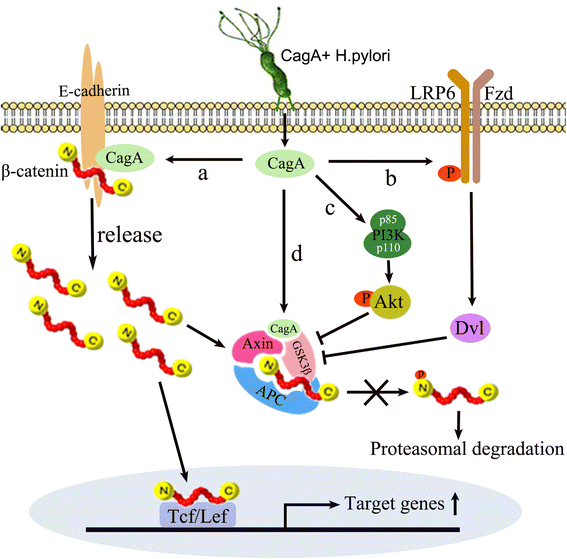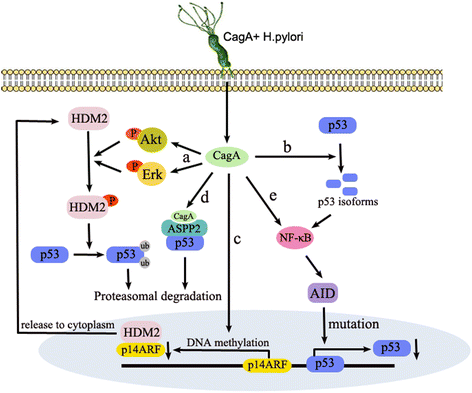Helicobacter pylori virulence factor CagA promotes tumorigenesis of gastric cancer via multiple signaling pathways
- PMID: 26160167
- PMCID: PMC4702319
- DOI: 10.1186/s12964-015-0111-0
Helicobacter pylori virulence factor CagA promotes tumorigenesis of gastric cancer via multiple signaling pathways
Abstract
Helicobacter pylori (H. pylori) infection is strongly associated with the development of gastric diseases but also with several extragastric diseases. The clinical outcomes caused by H. pylori infection are considered to be associated with a complex combination of host susceptibility, environmental factors and bacterial isolates. Infections involving H. pylori strains that possess the virulence factor CagA have a worse clinical outcome than those involving CagA-negative strains. It is remarkable that CagA-positive H. pylori increase the risk for gastric cancer over the risk associated with H. pylori infection alone. CagA behaves as a bacterial oncoprotein playing a key role in H. pylori-induced gastric cancer. Activation of oncogenic signaling pathways and inactivation of tumor suppressor pathways are two crucial events in the development of gastric cancer. CagA shows the ability to affect the expression or function of vital protein in oncogenic or tumor suppressor signaling pathways via several molecular mechanisms, such as direct binding or interaction, phosphorylation of vital signaling proteins and methylation of tumor suppressor genes. As a result, CagA continuously dysregulates of these signaling pathways and promotes tumorigenesis. Recent research has enriched our understanding of how CagA effects on these signaling pathways. This review summarizes the results of the most relevant studies, discusses the complex molecular mechanism involved and attempts to delineate the entire signaling pathway.
Figures


References
-
- Malfertheiner P, Megraud F, O'Morain CA, Atherton J, Axon AT, Bazzoli F, Gensini GF, Gisbert JP, Graham DY, Rokkas T, et al. Management of Helicobacter pylori infection--the Maastricht IV/ Florence Consensus Report. Gut. 2012;61(5):646–64. - PubMed
-
- Franceschi F, Tortora A, Gasbarrini G, Gasbarrini A. Helicobacter pylori and extragastric diseases. Helicobacter. 2014;19(Suppl 1):52–8. - PubMed
-
- Hsu PI, Lai KH, Hsu PN, Lo GH, Yu HC, Chen WC, Tsay FW, Lin HC, Tseng HH, Ger LP, et al. Helicobacter pylori infection and the risk of gastric malignancy. Am J Gastroenterol. 2007;102(4):725–30. - PubMed
-
- Fukase K, Kato M, Kikuchi S, Inoue K, Uemura N, Okamoto S, Terao S, Amagai K, Hayashi S, Asaka M. Effect of eradication of Helicobacter pylori on incidence of metachronous gastric carcinoma after endoscopic resection of early gastric cancer: an open-label, randomised controlled trial. Lancet. 2008;372(9636):392–7. - PubMed
-
- Delahay RM, Rugge M. Pathogenesis of Helicobacter pylori infection. Helicobacter. 2012;17(Suppl 1):9–15. - PubMed
Publication types
MeSH terms
Substances
LinkOut - more resources
Full Text Sources
Other Literature Sources
Medical
Research Materials

